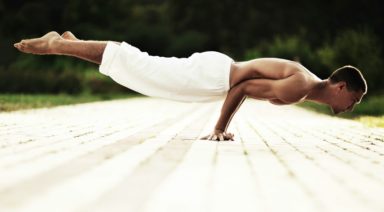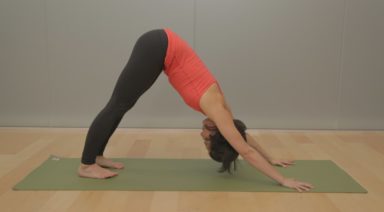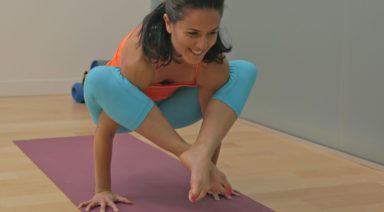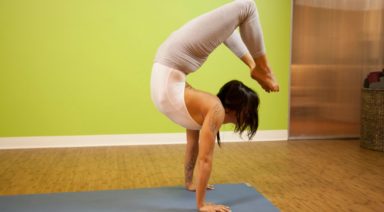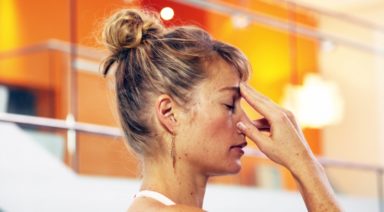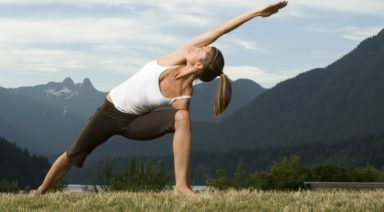Parivrtta Hasta Padangusthasana: Revolved Hand to Big Toe Pose

ADJUSTMENTS | BENEFITS | SEQUENCING | SANSKRIT | STEPS
Parivrtta hasta padangusthasana (par-ee-VRIT-tah HAS-ta pod-ang-goosh-TAHS-anna) is a balancing posture that asks for flexibility. Use props and modifications to make this challenging posture accessible from right where you are.
Philosophy + Origin
While the name of this pose is straightforward, many yoga teachers call it dancing Shiva, which opens up a whole new perspective for understanding parivrtta hasta padangusthasana. Traditional depictions of Nataraj, or dancing Shiva, show the arms and legs moving fluidly across the body, which is how the shape of this posture earned it its nickname. Shiva’s dance is often referred to as a cosmic dance of bliss, showing the universal cycles of creation and destruction, birth and death. Practicing dancing Shiva is a recognition of these cycles, and improves the ability to find balance and peace in the midst of eternal change.

ADJUSTMENTS/MODIFICATIONS:
- Place a strap around your lifted foot to create more space.
- Reach your back hand to a wall for extra support.
- Keep your gaze forward or to the side to help with balance.
- Keep your back hand on your hip for added stability.
STEP-BY-STEP:
- Begin standing at the top of your mat. Shift your weight into your right leg, pressing down through all four corners of the foot.
- Draw your left knee toward your chest. Loop your first and second finger of your right hand around your left big toe.
- Stand up tall. Lift your head up and drop your tailbone down.
- Place your left hand to your left hip, level your pelvis. Extend your left foot forward, pressing through your heel.
- Reach your right hand toward the back of your mat.
- Slowly start to move your gaze back towards your right hand.
- Hold this pose for 5-10 breaths before untwisting and slowly lowering the lifted leg down to the floor. Pause in standing for a few breaths before repeating on the other side.
PREPARATORY POSES:
- Revolved half moon | Parivrtta ardha chandrasana
- Revolved triangle pose | Parivrtta trikonasana
- Reclined hand to big toe pose | Supta hasta padangusthasana
SEQUENTIAL POSES:
- Tree pose | Vrksasana
- Dancers pose | Natarajasana
COUNTER POSES:
- Standing forward fold | Uttanasana
- Childs pose | Balasana
SANSKRIT:
- Parivrtta = revolved
- Hasta = hand
- Angustha = big toe
- Asana = pose
PHYSICAL BENEFITS:
- Strengthens and lengthens leg muscles.
- Stretches deep gluteal muscles and outer hips.
- Improves balance.
ENERGETIC BENEFITS:
- Improves mental and emotional balance.
- Boosts confidence.
- Energizes and steadies the mind.
Legal Disclaimer Before participating in any exercise program or using any fitness products or services that may be described and/or made accessible in or through the Gaia Website and/or the Services, you should consult with a physician or other healthcare provider. Read more about Gaia’s Terms Of Use.
Janu Sirsasana: Head to Knee Pose

ADJUSTMENTS | BENEFITS | PREP POSES | SANSKRIT | STEPS
Janu sirsasana (JAH-new shear-SHAHS-anna), may look simple, but it combines elements of a forward fold, twist, and side body stretch. Head to knee pose stretches the hamstrings, low back, and groins and can be adjusted to be very challenging or very relaxing.
Philosophy + Origin
While the name of the pose may seem to reveal an intention based on physical anatomy (head to knee pose), janu sirsasana is really all about turning inward and creating space for self-reflection. Instead of focusing on the intensity of the posture — or a desire to bring your head to your knee — turn your attention to the peace and stillness that may be hiding beneath the more prominent sensations.















